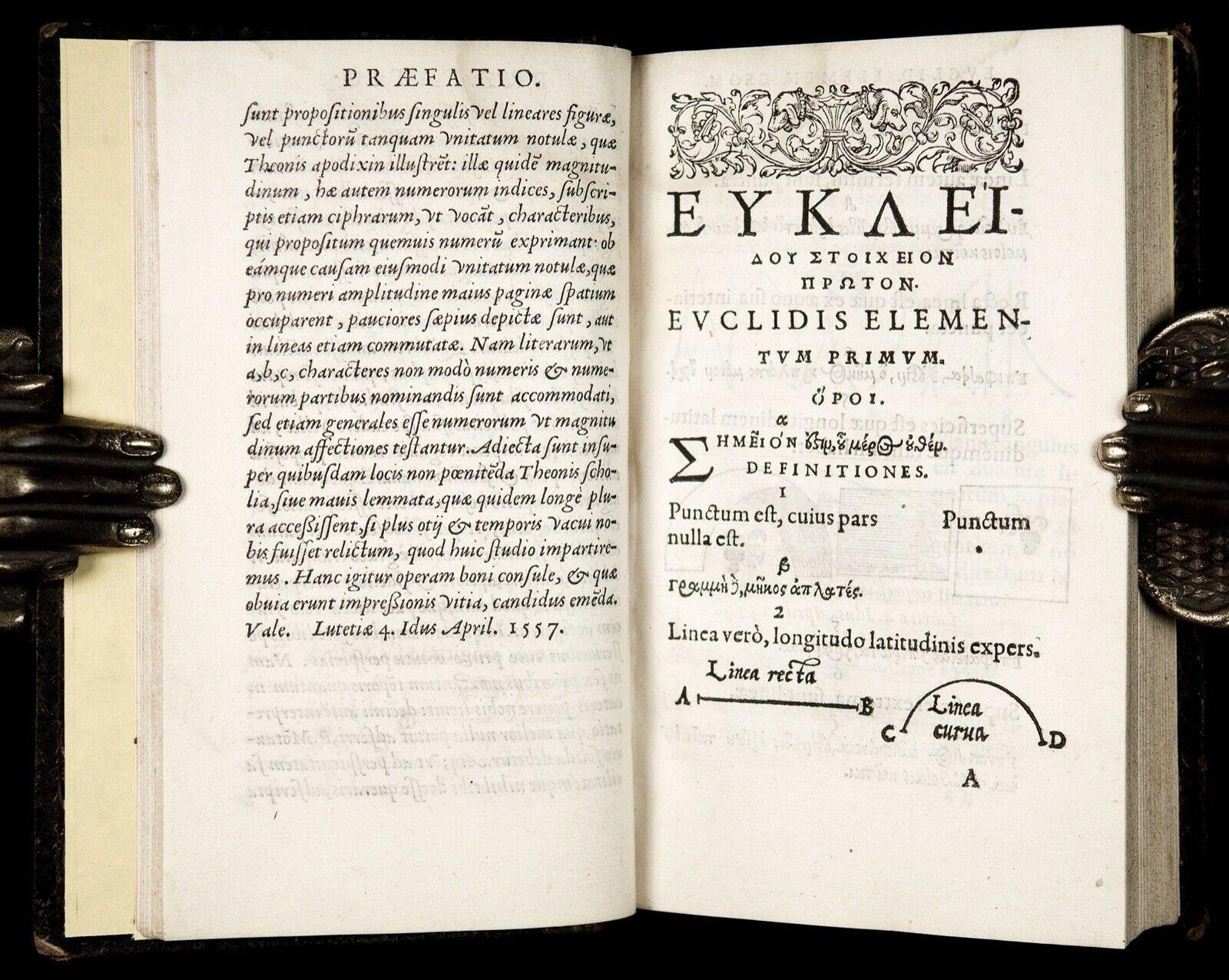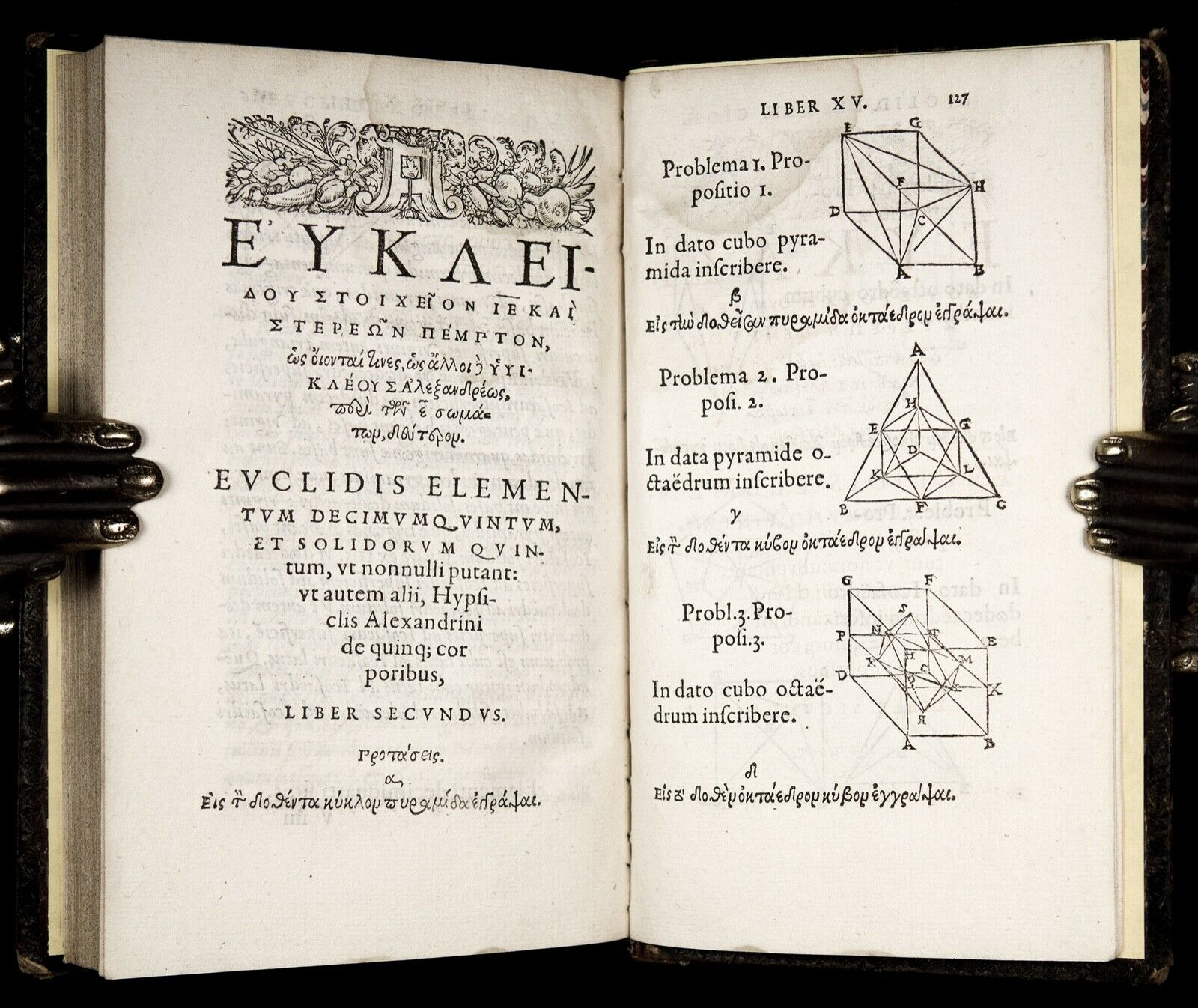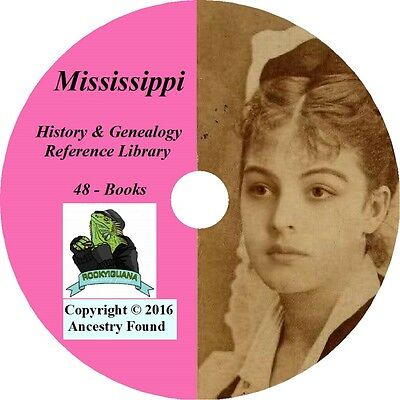-40%
1557 EUCLID ELEMENTS GREEK+LATIN Geometry Math RENAISSANCE 1ST Gracilis Edition
$ 179.52
- Description
- Size Guide
Description
[Early Printing - Paris] [Greek Classics] [History of Science - Mathematics - Ancient Greece] [Geometry - Euclidean]Printed in Paris by Guillaume Cavellat, 1557.
RARE FIRST ISSUE OF THE FIRST MAGNIEN-GRACILIS EDITION. Greek and Latin text.
"The first edition of [Stephanus] Gracilis with elaborately ornamented diagrams."
(Thomas-Stanford).
This is one of the scarcer 16th century editions of Euclid, featuring elegant roman and Greek typography and with its numerous woodcut diagrams embellished with charming floral ornaments. The book presents a very handsome example of Parisian Renaissance scientific printing!
The Latin translation and editing of the text for this edition was begun by Jean Magnien, who succeeded Oronce Fine as Professor of mathematics at the the Collège Royal in Paris; however, due to Magnien's untimely death, the work was continued and completed by Stephanus Gracilis who also supplied a long preface.
The translation of Book X is by Pierre de Montdoré, and was originally published by Vascosan in 1551.
The edition gives the enunciations of the theorems of Euclid's thirteen books and books 14-15, which are attributed to Hypsicles, with rare extracts from the demonstrations presented as the scholia of Theon of Alexandria
(all the text being printed in Greek and Latin).
This edition is based on "Grynaeus's system of principles.
A preface by [...] Gracilis explains that this edition was first conceived and prepared by Jean Magnien, and later completed, after the latter's untimely death, by Gracilis himself. Book X of the Elements follows the edition of it given by Pierre de Montdoré (Paris, Vascosan 1551).
The [Gracilis] edition enjoyed several reprints and was especially used in Jesuit colleges.
Like [the editions by] La Ramée (1545) and Caiani (1545), it gave no proofs of the propositions." (V. De Risi,
The Development of Euclidean Axiomatics
, Archive for History of Exact Sciences, Vol. 70, Issue 6, pp 591–676)
Euclid's
Elements
, written about 300 BC, is a "compilation of all earlier Greek mathematical knowledge since Pythagoras, organized into a consistent system [which served as] the common school textbook of geometry for hundreds of years."
(PMM)
Euclid's
Elements
is the oldest extant axiomatic deductive treatment of mathematics.
It has proven instrumental in the development of logic and modern science as a whole, and has been referred to as the most successful and influential textbook ever written. Its success can be attributed to its simple structure where each theorem follows logically from its predecessor.
The
Elements
is written in the form of a collection of definitions, postulates (axioms), propositions (theorems and constructions), and mathematical proofs of the propositions, all arranged in thirteen 'books.' cover Euclidean geometry and the ancient Greek version of elementary number theory. Having been first printed in Venice in 1482, the 'Elements' is one of the earliest mathematical works to be printed after the invention of the printing press and was estimated by Carl B. Boyer to be
second only to the Bible in the number of editions published
.
For centuries, when the quadrivium was included in the curriculum of all university students, knowledge of at least part of Euclid's Elements was required of all students. The austere beauty of Euclidean geometry has been seen by many in western culture as a glimpse of an otherworldly system of perfection and certainty.
The final two books of the Elements are spurious: Book 14, on polygonal numbers was probably written by Hypsicles, and Book 15, on Inscribing regular solids, by Isidoros of Miletos.
Bibliographical references:
Adams E-998; Thomas-Stanford, Early editions of Euclid's Elements, 30; Riccardi, Bibl. Euclidea, 1557:3; Steck, Bibl. Euclideana, III. 56; Smith, Rara arithmetica, p. 240; Renouard, ‘Cavellat' no 116. Pettegree, French Books, 70021; Graesse, II, p. 510; Schweiger I, p.110.
Physical description:
Octavo, textblock measures 16 1/2 cm x 10 cm. Bound in handsome 18th-century full marbled calf: boards with decorative gilt borders, spine tooled in gilt with floral ornaments, with raised bands and a (later) gilt-lettered label.
Foliation: [16], 130 (i.e. 160) leaves (forming 352 pages).
Signatures: â
8
ê
8
A-V
8
.
COMPLETE
.
Woodcut Cavellat's device of a hen within medallion on title; as well as a larger version of the on verso of final leaf. Numerous woodcut diagrams in text ornamented with fleurons. Decorative woodcut headpieces and initials.
Title-page with woodcut with woodcut Cavellat's 'fat hen' device within a medallion. Numerous woodcut geometrical diagrams in text, many with fleuron embellishments. Seventeen fine woodcut head-pieces with flowers, fruits and grotesques.
Text printed in single columns, in Greek and roman types. Preface (printed in italic) by Stephanus Gracilis (leaves â
2
r-ê
8
v) dated 10 April 1557.
Final leaf (V8) contains Errata on recto and a larger version of Cavellat's woodcut printer's mark on verso.
Condition:
Very Good antiquarian condition. Complete. Binding slightly rubbed, some wear to corners, very minor (and inconspicuous) repairs to joints; endpapers replaced at a later date. Interior with light water-staining to top inner corner of leaves throughout, somewhat more noticeable at the beginning and the end of the volume. Occasional light soiling. Title-page with a harmless marginal closed tear at top of the gutter (1" long) without loss. One leaf (O
1
) with small piece torn off at the top inner corner affecting a couple of words on recto and a small part of a diagram on verso. In all, a generally clean, solid, wide-margined example of this scarce, elegantly printed Renaissance edition of Euclid.
Please right-click on thumbnails below and choose "open image in a new window" option to see larger images.




















